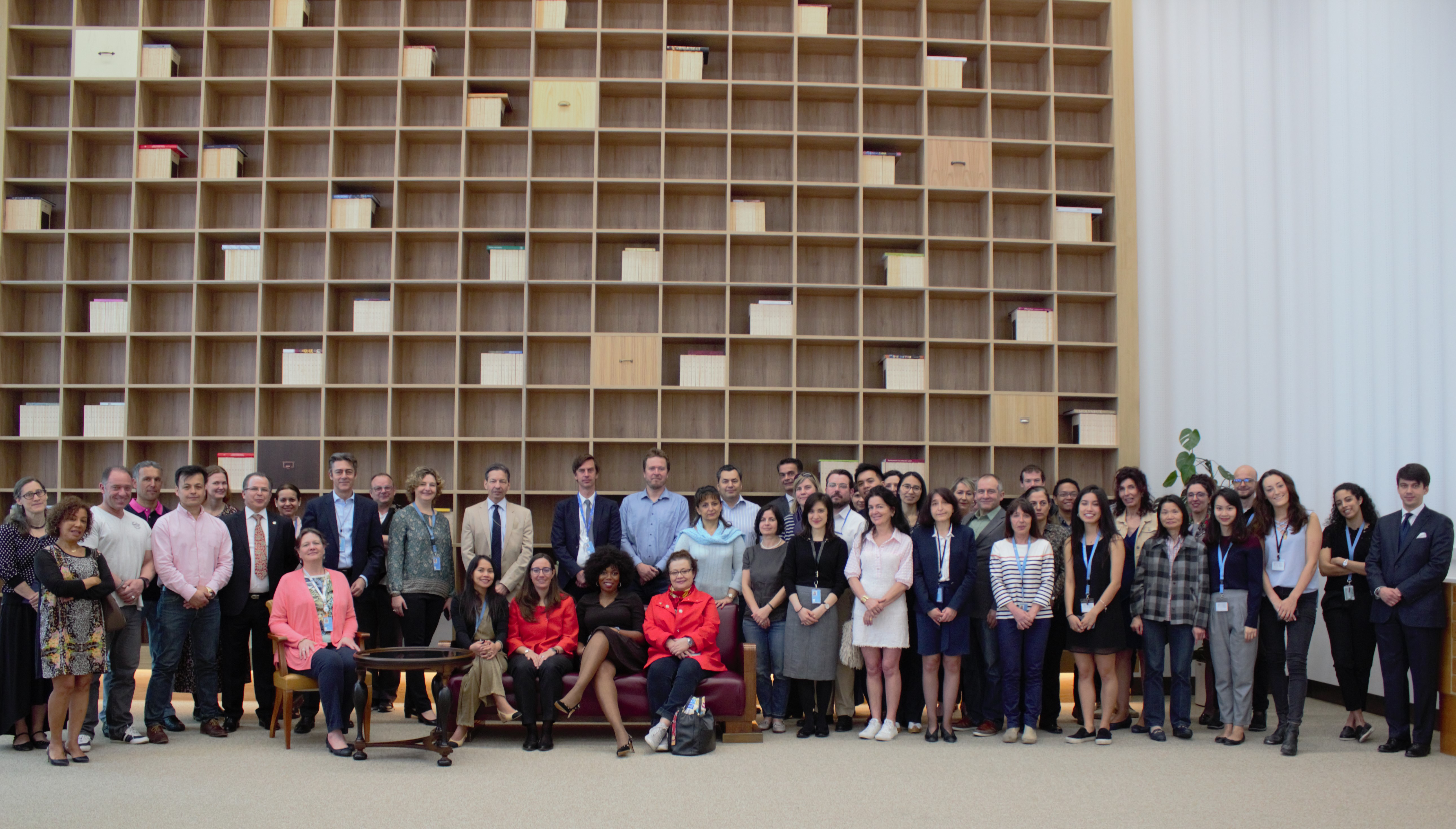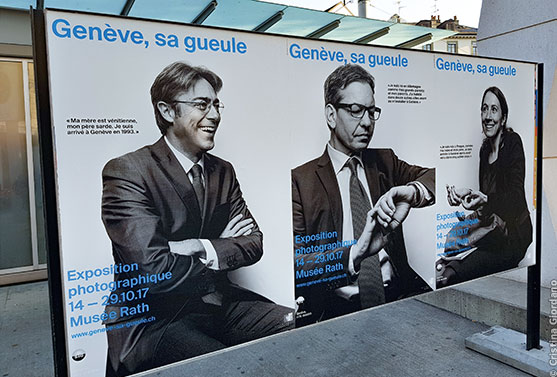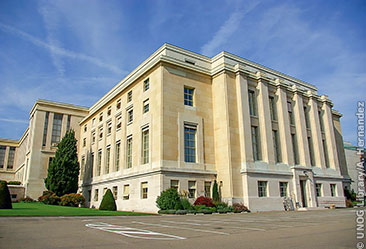CRISTINA GIORDANO AND SARAH JORDAN, UNOG – UN Special April 2018

Change ahead – The United Nations Library and the Centre for Learning and Multilingualism will soon be united under one roof in the Knowledge and Learning Commons.
Cristina Giordano and Sarah Jordan interview their respective bosses – Francesco Pisano, Director of the United Nations Library, and Thomas Neufing, Chief of the Centre for Learning and Multilingualism (CLM) on their vision for this future venture.
CG – After years of debate and in spite of technological advances, it is now clear that libraries are not dead! What is clear though is that they will have to change. The United Nations Library will be 100 next year. How do you see the future?
FP – As you say, there was a time when it was thought that technology would make libraries obsolete. This is clearly no longer the case and technology is not perceived as a threat. Libraries are turning digital and the question today is how technology can improve the way we store, organize and distribute knowledge. This is an interesting and exciting prospect for every librarian – what can they do to improve the service they give to their clients? The United Nations Library is a reputable institution, which started life within the League of Nations. Turning 100 is something we are very proud of. The plan now is to look forward to the next 100 years, and that is where the notion of knowledge and learning comes into play.
SJ – And what about the Centre for Learning and Multilingualism? We are not 100 years old, but is training changing too?
TN – Indeed it is. We are the “new kids on the block” compared to the Library, but are no longer in our infancy. In the last two decades, diminishing funds and the dispersed location of staff has required us to deliver training in a different way, not necessarily in the classroom. The first solution was to almost abandon face-to-face learning and to replace it with e-learning, as it was called at the time. It was hoped that e-learning would be a lot cheaper and more effective than face-to-face learning. I think this was a bit of an overreaction, from which we are now distancing ourselves. If we were a fieldbased entity, it would probably be different for us at the Centre. Here in Geneva, though, we have all our clients on our doorstep and social interaction is essential. Space is therefore very important to us. We want to foster informal learning and make learning available to our clients in a less rigid, more convivial way. People have less time and cannot always attend long sessions at fixed dates. Bitesized learning is the buzzword of the day! Like the Library, to remain stagnant and continue to do business as we did in the past is no longer an option.
CG – So what are the factors that bring the Library, knowledge and learning together?
FP – In my opinion, we have two fundamental linkages. First, we are client-driven. We act in our clients’ interests and help them achieve their aims. The second similarity is that we deal with substance, not processes. A librarian trains a person how to access knowledge – that is where the learning comes in. I’m excited to see what the chemical reaction will be when we put the two together. I think it will be positive: not destructive, but constructive. Genetically speaking, we are cousins!
TN – I remember bumping into Francesco shortly after we first met on the UN Leaders’ Programme. It must be about a year ago. We started talking about the Strategic Heritage Plan (SHP) and the idea of co-location was born.
FP – Yes, the idea has gained momentum very quickly. The Palais is being renovated in the context of the SHP. But there is also the “New Work” factor. Given the accelerators in our respective work domains, I think it is logical to bring our services together so that our customers can access learning and knowledge in one place on the UN Campus. I read in a specialized management magazine the other day that in Europe only 11% of people work alone or together in an office with four walls – so today, we are part of a shrinking minority.

Meant to be.
SJ – Do you have any examples of other organizations or structures that have gone through a similar process with a similar result?
FP – Many. At the beginning, when Thomas and I discussed our strategy, we wanted to keep away from long reinventing processes such as you find at the UN and identify instead winning ideas that have already worked outside the Organization. That is how we came upon the idea of the Commons. There are two types of commons: those adopted by large libraries known as knowledge commons, and those of universities and high schools, called learning commons. Our challenge is to try and combine the two and find the right mix of knowledge and learning. Notable examples are Harvard University Law School and the public library in Chicago, but there are many others in the United States, Germany, France and Switzerland. We recruited a researcher last year to help us study existing examples and our requirements so that we could present our ideas to our Management. The commons is a solution based on the evolution of libraries and learning centres. It has worked for others and we’re convinced that it will work for us too.
TN – It’s true that the model has been tested and developed in other areas. However, in our UN context, it is something of a pilot. During my assignment with OHRM at UN Headquarters in 2014-2015, I could already see the potential for collaboration between the learning team and the Dag Hammarskjöld Library. The idea, however, could not materialize because of the high turnover of relevant actors. So we are the pioneers in trying to create a knowledge and learning commons in the UN context. At CLM, we have always wanted to be closer to the safeguards of knowledge the Library represents and to tap into its huge reservoir. However, the 500 metres or so that has separated us to date has meant that this has not been possible.
SJ – So this project hinges on co-location?
TN – Absolutely. The Library is a beautiful building and has such an aura. It’s so much better than the facilities we have now. We share the same clientele – not just staff members, but member states and delegates. It will be easier for our 3,000 language students to find all our services in one location. They will bring new life to it – a kind of reenergizing impetus for an institution that is 100 years old! When I see the newly renovated events room that we could use for joint events – International Language Days for example – it is just fantastic. Michael Møller, our Director-General, the SDG 17 partnerships and the Chief Executive Board (CEB) leadership framework are all calling for cooperation and a more horizontal way of working – so now is the time to do it.
FP – Co-location has two advantages to my eyes. If you look at it through the eyes of a hypothetical P2 who graduates from Harvard Law School and is recruited by the UN, this person has studied in the commons there, has met librarians, but also training experts or a coach – all in one location. Once they arrive at the UN in Geneva, they will find the same configuration here – everything in one place. But I can see it from the point of view of the Organization too. Thomas and I are actually doing what the Director-General is encouraging the Organization to do. We are putting the narrative into action – walking the talk as they say. Working across silos, collaborating, inventing new things, doing more with less… I’m delighted that the Director-General and Clemens Adams are supporting this initiative. The contrary would have been a cold shower.
CG – So what are the next steps?
FP – We want to keep it simple because good ideas don’t need to be complicated. We have discussed the project within both teams. The next step is to bring the teams together. The premise is that co-locating two similar teams will have beneficial effects. We are going to select a number of ideas proposed by various team members. We will test them in 2018 and in 2019 we’ll be making them available to everyone in the Commons in Building B.
SJ – So clients will be informed of pilot courses and participate in them? Then based on ongoing feedback on what they liked and didn’t like, new products will be added to the catalogue?
FP – Yes – what everyone is talking about today is co-creation. We are going to try this using the skills of trainers and the skills of knowledge experts. Together we have the content and the instructional designers who make it digestible for the learner. The learners are aware of their requirements and know where the gaps are. We have 1.7 million books in the Library. I would say that the odds of us not being able to find something on a particular learning requirement are close to zero.
With the help of CLM experts we can match the knowledge to the learners’ requirements. In most cases, we should have a perfect combination.
SJ – What about the resources to do all this? Is it going to be part of the SHP? Is there going to be a budget for this?
FP – Of course there’s a large budget for this – it is the current budget. We are paid to run the Library and CLM is paid to organize courses. So the only cost will be that of moving offices. The whole building is going to be in upheaval so we thought that now was a good time to go ahead. If the SHP architects have to modify the B building, it might as well be in accordance with our requirements. And they are open to discussing this with us.

The library building.
TN – And the alternative would have been for us to have a new building for CLM. Our building is no longer fit for purpose and there are many issues about its location that mean that it is not sustainable. A brand new training centre would have been a heavy investment for the UN. The Knowledge and Learning Commons is a cost-effective solution for the Organization. We do, in fact already offer certain courses on the Library premises – for newcomers for example. We combine it with the Library tour. We also look forward to using the cinema – the beautiful Kazakh Room – as we did for International Mother Language Day when we screened a film on Quechua. We hope to show films in all six UN languages and to extend our cultural offering to add to all that the Library is already doing.
FP – I think there will be a snowball effect. People will feel empowered when they come to the B building – to the Commons – not only the Library – to learn, to read or consult records, to attend a cultural event… We want more people to discover the Library and to enjoy it. It will be good for us, but also for the Palais des Nations and the mission of the UN in Geneva because more people will be talking about us – about knowledge and multilingualism.
SJ – Will the Commons seek to attract new categories of users – young people and retirees, for example?
FP – We already attract many retirees and a lot of external researchers come here too. Working together will allow us to welcome more people. We are open to external researchers, but we are not a public library. Ours is a different mission. With CLM, there will be more learning food for more people so we will add more tables in the restaurant…
TN – Spouses already follow our language courses and teenagers come to the HIV prevention programme. We are already a learning centre not only for the UN community, but beyond. One thing I would like to say is that we’re not talking about a merger here. Both the Library and CLM will continue to run their core businesses. But the chemical reaction that Francesco mentioned earlier will create something new, something better with more to offer than we have now. We are not doing this for rewards, we are doing this because we believe in the potential, but we do hope to stimulate others to explore synergies too.
SJ – It’s going to move forward pretty fast then?
FP – Our dream is that in one year from now, the UN top management will see this as an example and tell other parts of the Secretariat: “They did it – why can’t you?” We have gone forward very quickly – from the thinking and dreaming stage, to getting Management approval, to liberating the office space, also thanks to the collaboration we have received from Administration and technical central services. When the clients arrive, the rest will happen naturally. You will see!